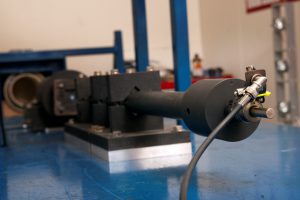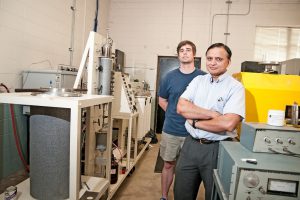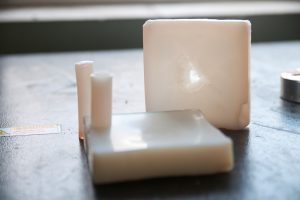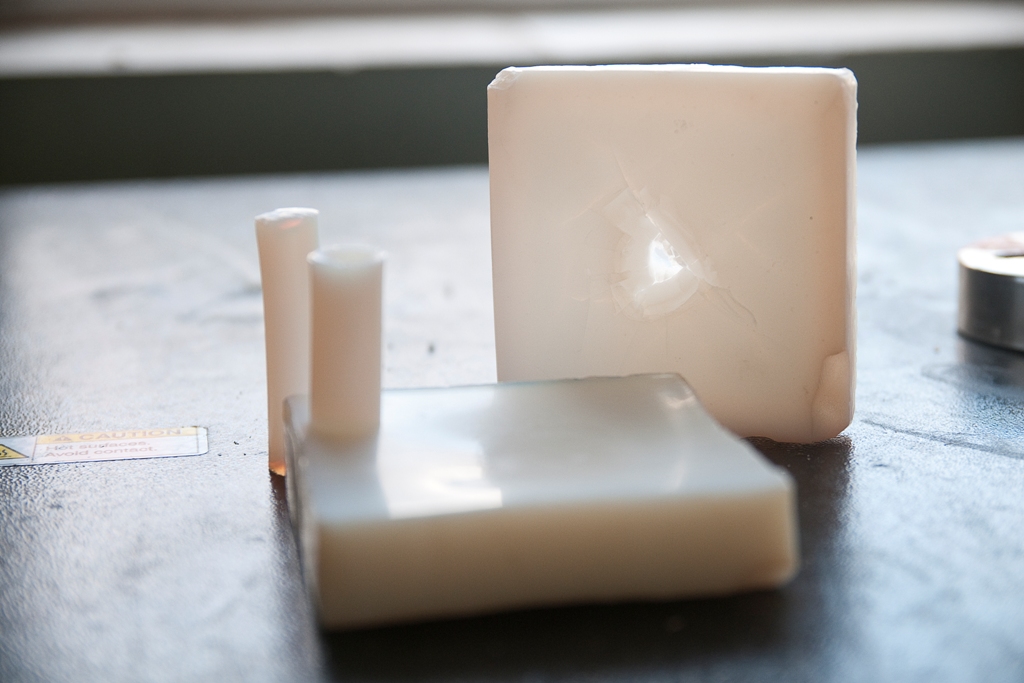By Mary Wymer
Photos by Jeff Hanson and Samantha Hernandez
Is it smoke? A frozen cloud, perhaps? Maybe a hologram? Is it a solid? A gel?
From its early development in the 1930s to being named the World’s Lightest Solid by Guinness Records in 2002, materials known as aerogels have made significant impacts on numerous scientific areas, including insulation, filtration and remediation.
NASA has used aerogels to catch comet particles with the Stardust Mission and to insulate the Mars exploration rovers from that planet’s extremely cold temperatures.

Within the last two decades, aerogels have entered commercial markets with products like residential and commercial insulation, remediation techniques for oil spills in water, and transparent window insulation. While most of these products are some years away from mainstream use, aerogels will affect more than scientific communities, alone.
So, what exactly are they? These highly-porous, solid materials have the lowest density of any solid known to man. Specifically, silica aerogels are 1,000 times less dense than glass. Aerogels are not gel material; the physical properties are solid. Although it is a solid, it begins as a gel and is prepared through a number of chemical processes. It almost weighs less, in its original form, than air.
Dr. Samit Roy, the William D. Jordan Professor of Aerospace Engineering and Mechanics at The University of Alabama, has collaborated with NASA for the past four years on ways to strengthen aerogel without compromising its positive attributes, including its lightweight and thermal insulation properties.
Roy is working to create a fuel tank from aerogels – one that will weigh less than 10 percent of the fuel’s weight. NASA, and the entire aerospace industry, seeks to develop lighter, more fuel efficient vehicles.

By crosslinking a polymer with the aerogel, Roy coats the inside of the aerogel without filling in its pores. This provides the aerogel structural strength while allowing it to remain lightweight. Roy’s specific research at UA focuses on these Crosslinked Silica Aerogels, or CSAs.
NASA has expressed much interest in the aerogel because of its multiple functions. In addition to being lightweight, the aerogel is, after its crosslinked, structurally sound, able to withstand low temperatures and serve as a good insulator.
Roy’s initial NASA funding – some $600,000 – from the Glenn Research Center was for testing completed in 2009. To determine the CSA strength, Roy conducted numerous tests by forming the CSAs into cylindrical specimens and applying pressure to determine the material’s ability to withstand compression. He also tested its capacity to withstand breakage. Perhaps the most impressive results from CSA’s testing came in a ballistics lab. There, it was shown the material, even when subjected to high velocity impact, would not shatter.
“We found that by crosslinking the aerogel with the polymer, the material is now 40 times stronger,” said Roy.

Roy’s research was funded through NASA’s Low Emission Alternative Power Initiative. The initiative seeks to use alternative fuel sources for its aircraft and spacecraft.
Jet fuel, used in spacecraft, produces a lot of carbon emissions. Using liquid hydrogen as an alternative fuel is appealing, Roy says, because it creates very low emissions. Storing it, however, is challenging. The CSAs ability to withstand the cold temperatures, such as those of liquid hydrogen, is a step toward operating aircraft and spacecraft with a fuel that is better for the environment.
NASA seeks to use CSAs in creating a fuel tank weighing less than 10 percent of the fuel it holds. To make a tank from the CSAs requires a thin metal lining to prevent the CSA from absorbing the fuel, but the main structural tank support and insulation would come from the CSA.
With the first stage of his research complete, Roy has applied for additional funding from NASA to research ways to reduce the high cost of making CSAs. The next step is scaling everything up to start building the prototype tank.
And therein is the challenge: “It’s like going from making toy cars to making real cars,” says Roy.
Contact
Christoffer Feemster or Linda Hill, UA Public Relations, 205/348-8325, lhill@ur.ua.edu
Source
Kathy M. Wilson, UA Women’s Resource Center, 205/348-5040, kwilson@sa.ua.edu
